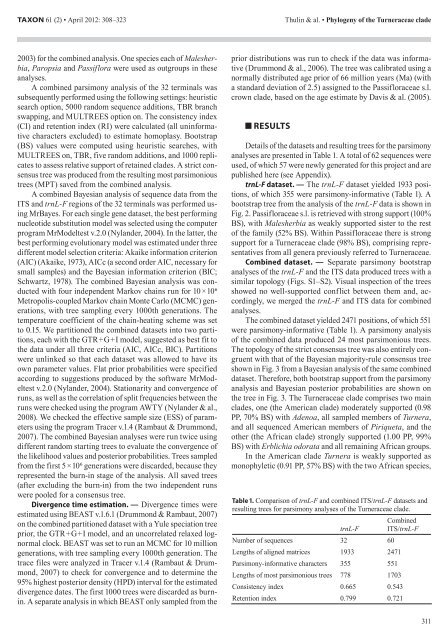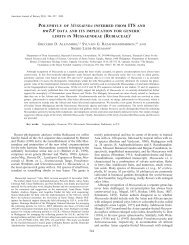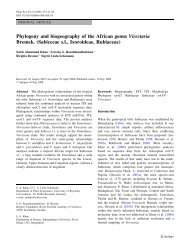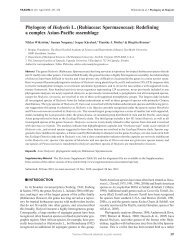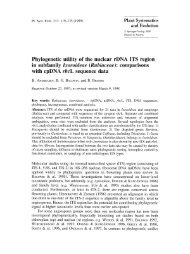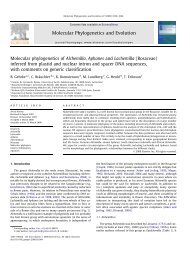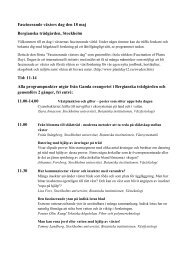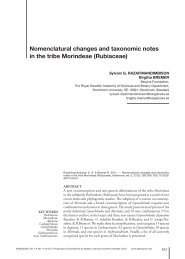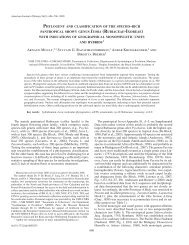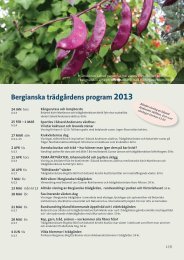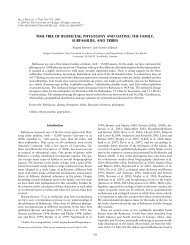Thulin et al. 2012
Thulin et al. 2012
Thulin et al. 2012
You also want an ePaper? Increase the reach of your titles
YUMPU automatically turns print PDFs into web optimized ePapers that Google loves.
TAXON 61 (2) • April <strong>2012</strong>: 308–323<br />
2003) for the combined an<strong>al</strong>ysis. One species each of M<strong>al</strong>esherbia,<br />
Paropsia and Passiflora were used as outgroups in these<br />
an<strong>al</strong>yses.<br />
A combined parsimony an<strong>al</strong>ysis of the 32 termin<strong>al</strong>s was<br />
subsequently performed using the following s<strong>et</strong>tings: heuristic<br />
search option, 5000 random sequence additions, TBR branch<br />
swapping, and MULTREES option on. The consistency index<br />
(CI) and r<strong>et</strong>ention index (RI) were c<strong>al</strong>culated (<strong>al</strong>l uninformative<br />
characters excluded) to estimate homoplasy. Bootstrap<br />
(BS) v<strong>al</strong>ues were computed using heuristic searches, with<br />
MULTREES on, TBR, five random additions, and 1000 replicates<br />
to assess relative support of r<strong>et</strong>ained clades. A strict consensus<br />
tree was produced from the resulting most parsimonious<br />
trees (MPT) saved from the combined an<strong>al</strong>ysis.<br />
A combined Bayesian an<strong>al</strong>ysis of sequence data from the<br />
ITS and trnL-F regions of the 32 termin<strong>al</strong>s was performed using<br />
MrBayes. For each single gene datas<strong>et</strong>, the best performing<br />
nucleotide substitution model was selected using the computer<br />
program MrModeltest v.2.0 (Nylander, 2004). In the latter, the<br />
best performing evolutionary model was estimated under three<br />
different model selection criteria: Akaike information criterion<br />
(AIC) (Akaike, 1973), AICc (a second order AIC, necessary for<br />
sm<strong>al</strong>l samples) and the Bayesian information criterion (BIC;<br />
Schwartz, 1978). The combined Bayesian an<strong>al</strong>ysis was conducted<br />
with four independent Markov chains run for 10 × 106<br />
M<strong>et</strong>ropolis-coupled Markov chain Monte Carlo (MCMC) generations,<br />
with tree sampling every 1000th generations. The<br />
temperature coefficient of the chain-heating scheme was s<strong>et</strong><br />
to 0.15. We partitioned the combined datas<strong>et</strong>s into two partitions,<br />
each with the GTR + G + I model, suggested as best fit to<br />
the data under <strong>al</strong>l three criteria (AIC, AICc, BIC). Partitions<br />
were unlinked so that each datas<strong>et</strong> was <strong>al</strong>lowed to have its<br />
own param<strong>et</strong>er v<strong>al</strong>ues. Flat prior probabilities were specified<br />
according to suggestions produced by the software MrModeltest<br />
v.2.0 (Nylander, 2004). Stationarity and convergence of<br />
runs, as well as the correlation of split frequencies b<strong>et</strong>ween the<br />
runs were checked using the program AWTY (Nylander & <strong>al</strong>.,<br />
2008). We checked the effective sample size (ESS) of param<strong>et</strong>ers<br />
using the program Tracer v.1.4 (Rambaut & Drummond,<br />
2007). The combined Bayesian an<strong>al</strong>yses were run twice using<br />
different random starting trees to ev<strong>al</strong>uate the convergence of<br />
the likelihood v<strong>al</strong>ues and posterior probabilities. Trees sampled<br />
from the first 5 × 106 generations were discarded, because they<br />
represented the burn-in stage of the an<strong>al</strong>ysis. All saved trees<br />
(after excluding the burn-in) from the two independent runs<br />
were pooled for a consensus tree.<br />
Divergence time estimation. — Divergence times were<br />
estimated using BEAST v.1.6.1 (Drummond & Rambaut, 2007)<br />
on the combined partitioned datas<strong>et</strong> with a Yule speciation tree<br />
prior, the GTR + G + I model, and an uncorrelated relaxed lognorm<strong>al</strong><br />
clock. BEAST was s<strong>et</strong> to run an MCMC for 10 million<br />
generations, with tree sampling every 1000th generation. The<br />
trace files were an<strong>al</strong>yzed in Tracer v.1.4 (Rambaut & Drummond,<br />
2007) to check for convergence and to d<strong>et</strong>ermine the<br />
95% highest posterior density (HPD) interv<strong>al</strong> for the estimated<br />
divergence dates. The first 1000 trees were discarded as burnin.<br />
A separate an<strong>al</strong>ysis in which BEAST only sampled from the<br />
<strong>Thulin</strong> & <strong>al</strong>. • Phylogeny of the Turneraceae clade<br />
prior distributions was run to check if the data was informative<br />
(Drummond & <strong>al</strong>., 2006). The tree was c<strong>al</strong>ibrated using a<br />
norm<strong>al</strong>ly distributed age prior of 66 million years (Ma) (with<br />
a standard deviation of 2.5) assigned to the Passifloraceae s.l.<br />
crown clade, based on the age estimate by Davis & <strong>al</strong>. (2005).<br />
REsULTs<br />
D<strong>et</strong>ails of the datas<strong>et</strong>s and resulting trees for the parsimony<br />
an<strong>al</strong>yses are presented in Table 1. A tot<strong>al</strong> of 62 sequences were<br />
used, of which 57 were newly generated for this project and are<br />
published here (see Appendix).<br />
trnL-F datas<strong>et</strong>. — The trnL-F datas<strong>et</strong> yielded 1933 positions,<br />
of which 355 were parsimony-informative (Table 1). A<br />
bootstrap tree from the an<strong>al</strong>ysis of the trnL-F data is shown in<br />
Fig. 2. Passifloraceae s.l. is r<strong>et</strong>rieved with strong support (100%<br />
BS), with M<strong>al</strong>esherbia as weakly supported sister to the rest<br />
of the family (52% BS). Within Passifloraceae there is strong<br />
support for a Turneraceae clade (98% BS), comprising representatives<br />
from <strong>al</strong>l genera previously referred to Turneraceae.<br />
Combined datas<strong>et</strong>. — Separate parsimony bootstrap<br />
an<strong>al</strong>yses of the trnL-F and the ITS data produced trees with a<br />
similar topology (Figs. S1–S2). Visu<strong>al</strong> inspection of the trees<br />
showed no well-supported conflict b<strong>et</strong>ween them and, accordingly,<br />
we merged the trnL-F and ITS data for combined<br />
an<strong>al</strong>yses.<br />
The combined datas<strong>et</strong> yielded 2471 positions, of which 551<br />
were parsimony-informative (Table 1). A parsimony an<strong>al</strong>ysis<br />
of the combined data produced 24 most parsimonious trees.<br />
The topology of the strict consensus tree was <strong>al</strong>so entirely congruent<br />
with that of the Bayesian majority-rule consensus tree<br />
shown in Fig. 3 from a Bayesian an<strong>al</strong>ysis of the same combined<br />
datas<strong>et</strong>. Therefore, both bootstrap support from the parsimony<br />
an<strong>al</strong>ysis and Bayesian posterior probabilities are shown on<br />
the tree in Fig. 3. The Turneraceae clade comprises two main<br />
clades, one (the American clade) moderately supported (0.98<br />
PP, 70% BS) with Adenoa, <strong>al</strong>l sampled members of Turnera,<br />
and <strong>al</strong>l sequenced American members of Piriqu<strong>et</strong>a, and the<br />
other (the African clade) strongly supported (1.00 PP, 99%<br />
BS) with Erblichia odorata and <strong>al</strong>l remaining African groups.<br />
In the American clade Turnera is weakly supported as<br />
monophyl<strong>et</strong>ic (0.91 PP, 57% BS) with the two African species,<br />
Table 1. Comparison of trnL-F and combined ITS/trnL-F datas<strong>et</strong>s and<br />
resulting trees for parsimony an<strong>al</strong>yses of the Turneraceae clade.<br />
Combined<br />
trnL-F ITS/trnL-F<br />
Number of sequences 32 60<br />
Lengths of <strong>al</strong>igned matrices 1933 2471<br />
Parsimony-informative characters 355 551<br />
Lengths of most parsimonious trees 778 1703<br />
Consistency index 0.665 0.543<br />
R<strong>et</strong>ention index 0.799 0.721<br />
311


